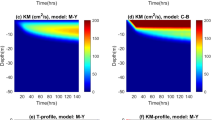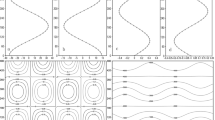Abstract
The classical Ekman spiral is generated by surface wind stress with constant eddy viscosity in a homogeneous ocean. In real oceans, the eddy viscosity varies due to turbulent mixing caused by surface wind and buoyancy forcing. Horizontally inhomogeneous density produces vertical geostrophic shear which contributes to current shear that also affects the Ekman spiral. Based on similar theoretical framework as the classical Ekman spiral, the baroclinic components of the Ekman spiral caused by the horizontally inhomogeneous density are obtained analytically with the varying eddy viscosity calculated from surface wind and buoyancy forcing using the K-profile parameterization (KPP). Along with the three existing types of eddy viscosity due to pure wind forcing (zero surface buoyancy flux), such an effect is evaluated using the climatological monthly mean data of surface wind stress, buoyancy flux, ocean temperature and salinity, and mixed layer depth.



















Similar content being viewed by others
References
Berger, B.W., Grisogono, B. (1998). The baroclinic, variable eddy viscosity Ekman layer. Bound.-Lay. Meteorol., 87, 363–380.
Chereskin, T.K. (1995). Direct evidence for an Ekman balance in the California Current. J. Geophys. Res., 100, 18261–18269.
Chu, P.C. (1993). Generation of low frequency unstable modes in a coupled equatorial troposphere and ocean mixed layer. J. Atmos. Sci., 50, 731–749.
Chu, P.C. (1995). P-vector method for determining absolute velocity from hydrographic data. Marine Tech. Soc. J., 29, 2, 3–14.
Chu, P.C. (2000). P-vector spirals and determination of absolute velocities. J. Oceanogr., 56, 591–599.
Chu, P. C. (2006). P-Vector Inverse Method. Springer, 605 pp.
Chu, P.C., Garwood, R.W. Jr. (1991). On the two-phase thermodynamics of the coupled cloud-ocean mixed layer. J. Geophys. Res., 96, 3425–3436.
Chu, P.C., Liu, Q.-Y., Jia, Y.-L., Fan, C.W. (2002). Evidence of a barrier layer in the Sulu and Celebes Seas. J. Phys. Oceanogr., 32, 3299–3309.
Chu, P.C., Fan, C.W. (2010). Optimal linear fitting for objective determination of ocean mixed layer depth from glider profiles. J. Atmos. Oceanic Technol., 27, 1893–1898.
Chu, P.C. and Fan, C.W. (2011). Maximum angle method for determining mixed layer depth from seaglider data. J. Oceanogr., 67, 219–230.
DaSilva, A., Young, A. C., Levitus, S. (1994). Atlas of Surface Marine Data, Volume 1: Algorithms and Procedures, Number 6, NOAA/NODC.
Ekman, V. W. (1905). On the influence of the earth’s rotation on ocean-currents. Ark. Mat. Astron. Fys., 2, 1–52.
Garwood, R.W. Jr. (1977). An oceanic mixed layer capable of simulating cyclic states. J. Phys. Oceanogr., 7, 455–468.
Grachev A.A., Andreas E.L, Fairall C.W., Guest P.S., Persson P.O.G. (2008). Turbulent measurements in the stable atmospheric boundary layer during SHEBA: ten years after. Acta Geophysica. 56, 1, 142–166.
Grisogono, B. (1995). A generalized Ekman layer profile with gradually varying eddy diffusivities. Quart. J. Roy. Meteorol. Soc. 121, 445–453.
Hunkins, K. (1966). Ekman drift currents in the Arctic Ocean. Deep-Sea Res. 13, 607–620.
Kraus, E. B., Turner, J.S. (1967). A one-dimensional model of the seasonal thermocline, Part II, Tellus, 19, 98–105.
Large, W.G., McWilliams, J. C., Doney, S. C. (1994). Oceanic vertical mixing: A review and a model with a non-local K-profile boundary layer parameterization. Rev. Geophys., 32, 363–403.
Lenn, Y., Chereskin, T.K. (2009). Observation of Ekman Currents in the Southern Ocean. J. Phys. Oceanogr., 39, 768–779.
Lettau, H. H., Dabberdt, W. F. (1970). Variangular Wind Spirals. Boundary‐Layer Meteorol. 1, 64–79.
Lombardo, C. P., M. C. Gregg (1989). Similarity scaling of viscous and thermal dissipation in a convecting surface boundary layer, J. Geophys. Res., 94, 6273–6284.
McWilliams, J. C., Huckle, E. (2006). Ekman layer rectification. J. Phys. Oceanogr., 36, 1646–1659.
McWilliams, J. C., Huckle, E. & Shchepetkin, A. F. (2009). Buoyancy effects in a stratified Ekman layer. J. Phys. Oceanogr., 39, 2581–2599.
Monin, A. S., Obukhov, A. M. (1954). Basic laws of turbulent mixing in the surface layer of the atmosphere. Trudy Geofiz. Inst. Acad. Nauk SSSR., 24, 163–187.
Monterey, G., Levitus, S. (1997). Seasonal Variability of Mixed Layer Depth for the World Ocean. NOAA Atlas NESDIS 14, U.S. Gov. Printing Office, Wash., D.C., 96 pp.
O’Brien, J. J. (1970). A note on the vertical structure of the eddy exchange coefficient in the planetary boundary layer. J. Atmos. Sci., 27, 1213–1215.
Obukhov, A.M. (1946). Turbulence in an atmosphere with a non‐uniform temperature. Trudy Inst. Teoret. Geophys. Akad. Nauk SSSR. 1: 95–115 (translation in: Boundary‐Layer Meteorol. 1971. 2: 7–29).
Price, J. F., Weller, R. A., Schudlich, R. R. (1987). Wind-driven ocean currents and Ekman transport. Science, 238: 1534–1538.
Richman, J.F., deSzoeke, R., Davis, R.E. (1987). Measurements of near-surface shear in the Ocean. J. Geophys. Res., 92, 2851–2858.
Song, J.-B., Huang, Y.-S. (2011). An approximate solution of wave-modified Ekman current for gradually varying eddy viscosity. Deep-Sea Res. I, 58, 668–676.
Stacey, M.W., Pond, S., LeBlond, P. H. (1986). A wind-forced Ekman spiral as a good statistical fit to low-frequency currents in a coastal strait. Science, 233, 470–472.
Steger, J., Collins, C.A., and Chu, P.C. (1998). Circulation in the Archipelago de Colon (Galapagos Islands), November 1993. Deep-Sea Res. II, 45, 1093–1114.
Taylor, J. R., Sarkar, S. (2008). Stratification effect in a bottom Ekman layer. J. Phys. Oceanogr., 38, 2535–2553.
Zikanov, O., Slinn, D.N., Dhanak, M.R. (2003). Large-eddy simulations of the wind-induced turbulent Ekman layer. J. Fluid Mech., 495, 343–368.
Acknowledgments
The author would like to thank Mr. Chenwu Fan for his outstanding efforts on the computation and graphics.
Author information
Authors and Affiliations
Corresponding author
Appendices
Appendix 1: General Solutions of Eq. (22)
Let the Ekman currents (u E, v E) be represented by a complex variable ψ,
Substitution of (52) into (22) leads to
where
The function \(\phi\) represents the baroclinic effect. The second-order differential equation (53) needs two boundary conditions. The surface boundary condition (14) becomes
The lower boundary condition of equation (53) is given by
to guarantee a physically meaningful solution, i.e., \(\left| \psi \right| \,\) cannot be infinity as \(\sigma \to \infty\). Eq. (53) is a linear inhomogeneous ordinary differential equation with the depth-varying coefficient K (z). Following Berger and Grisogono (1998), studying the Ekman atmospheric boundary layer, an approximate solution to the inhomogeneous problem (53) can be found with the variation of parameters technique, provided that an approximate solution of the homogeneous problem of (53),
exists. If two independent approximate solutions to homogeneous problem of Eq. (57) are given by \(\psi_{1} (\sigma )\) and \(\psi_{2} (\sigma )\), the general solution of Eq. (53) is given by
where
Appendix 2: The WKB Method for Solving Eq. (57)
The WKB method can be used to obtain a good approximate solution of Eq. (57) if the vertical variation of K (σ) is slower than that of \(\psi (\sigma )\) (Grisogono 1995),
where \(\varepsilon\) is a presumably small parameter. Substitution of (61) into (57) leads to a set of equations in terms of powers of \(\varepsilon\). If K (σ) does not vary too quickly with depth, we have
Solving for the first two terms S 0 and S 1 yields
Thus, the two approximate solutions of the homogeneous equation (55) are
where
Substitution of (55) and (66) into (59) and (60) gives
Substitution of (65) into (58) gives
It is noted that F (σ) < 0 leads to
This leads to
Substitution of (69) into the surface boundary condition (55) gives
Rights and permissions
About this article
Cite this article
Chu, P.C. Ekman Spiral in a Horizontally Inhomogeneous Ocean with Varying Eddy Viscosity. Pure Appl. Geophys. 172, 2831–2857 (2015). https://doi.org/10.1007/s00024-015-1063-4
Received:
Revised:
Accepted:
Published:
Issue Date:
DOI: https://doi.org/10.1007/s00024-015-1063-4




